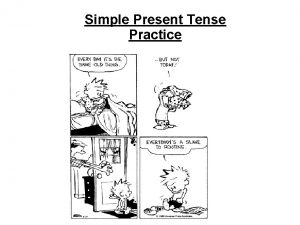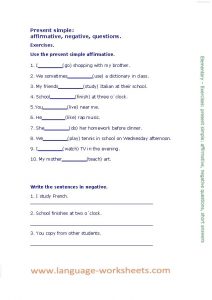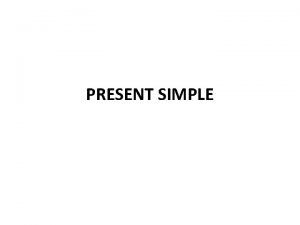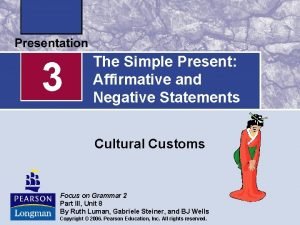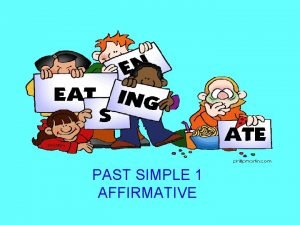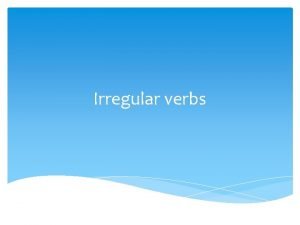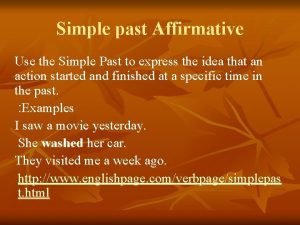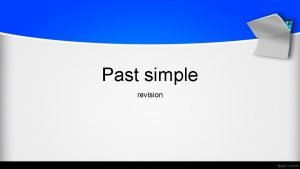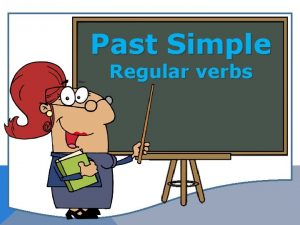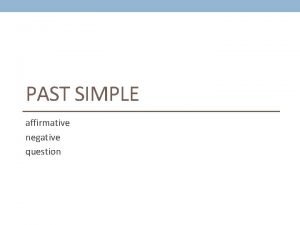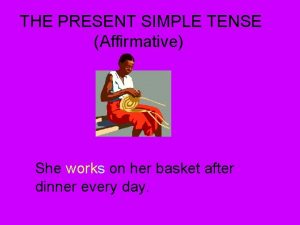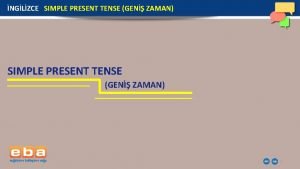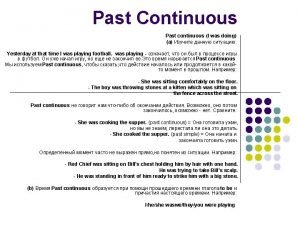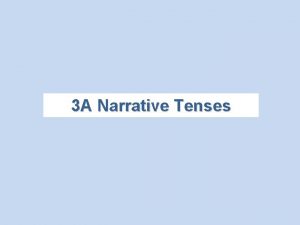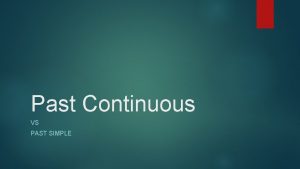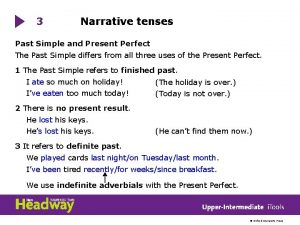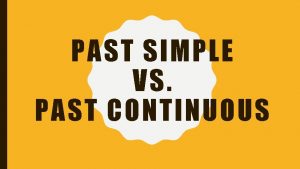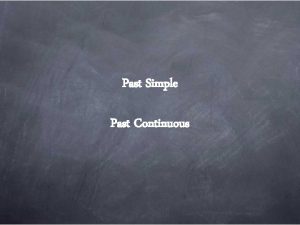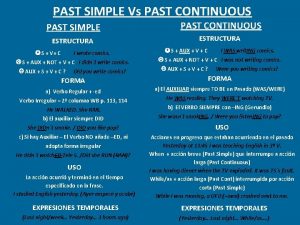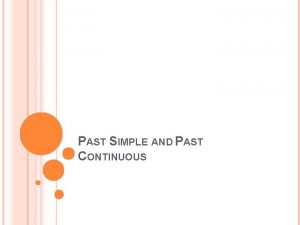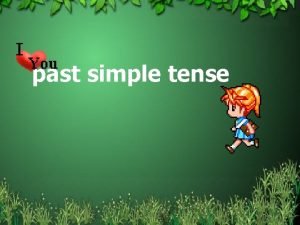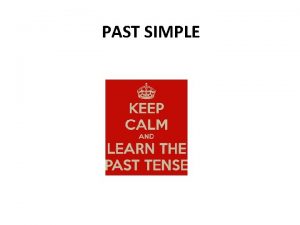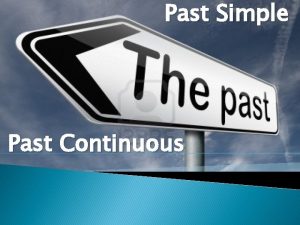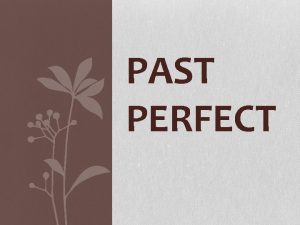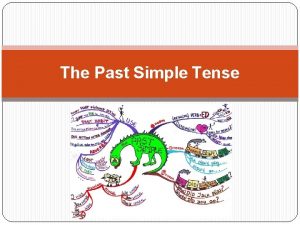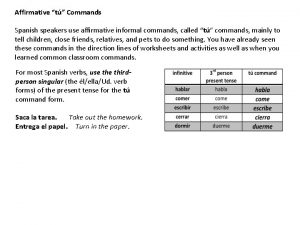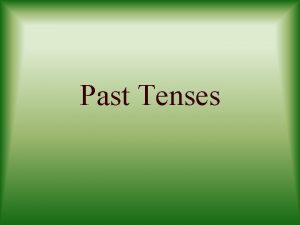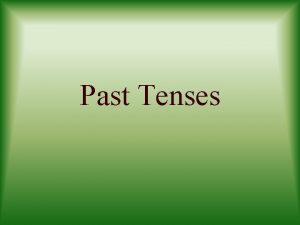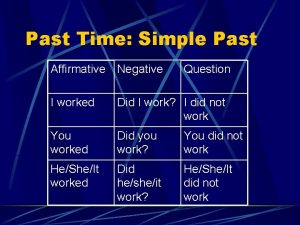Simple past Affirmative Use the Simple Past to





















- Slides: 21

Simple past Affirmative Use the Simple Past to express the idea that an action started and finished at a specific time in the past. : Examples I saw a movie yesterday. She washed her car. They visited me a week ago. http: //www. englishpage. com/verbpage/simplepas t. html


Simple Past Negative and Question Negatives in the simple present are formed by adding didn't. Yes/no questions are also created using the auxiliary did. e. g: I had a car. I didn’t have a car. Did you have a car? What did you have? He was here yesterday. He wasn't here yesterday. Was he here yesterday? Where was he yesterday? http: //www. englishpage. com/verbpage/simplepas t. html

Make Questions: The fox was in the garden. (where) She bought an old car. (what) They traveled across Canada by bike. (how) Make negative: She studied her lessons. They wore jeans. He left yesterday.


Simple Present Affirmative Simple presnt tense is used when we speak about habits and things happened regularly. e. g : I sing everyday. He swims every Friday. He watches TV every night. Choose: They ( come , comes ) early. She ( drive , drives ) fast. http: //web 2. uvcs. uvic. ca/elc/studyzone/330/grammar/pr es. htm


Present Simple Negative and Question Negatives in the simple present are formed by adding don't or doesn't before the simple form of the verb. Questions are also created using the auxiliary do/does. I don’t sing. Do you sing? What do you sing? She doesn’t wash the dishes. Does she wash the dishes? What does she wash? http: //web 2. uvcs. uvic. ca/elc/studyzone/330/grammar/pr esnq. htm

Make yes/no questions: We get wool from sheep. They live in teepees. Make Negative: He teaches physics. Make Question: She drinks coffee every morning. They sleep early. He swims in the river.


Passive Form In passive sentences, the thing receiving the action is the subject of the sentence and the thing doing the action is optionally included near the end of the sentence. You can use the passive form if you think that the thing receiving the action is more important or should be emphasized. You can also use the passive form if you do not know who is doing the action or if you do not want to mention who is doing the action. [Thing receiving action] + [be] + [past participle of verb] n Examples : The dishes are washed by her. n http: //www. englishpage. com/verbpage/activepassive. html n

Passive Voice The structure of the passive voiceis very simple subject + auxiliary verb (be) + main verb (past (participle The main verb is always in its past participle form. Simple Present: Simple Past: ( Active) Everybody drinks water. ( Passive) Water is drunk by everybody. ( Active) She received an e-mail yesterday. ( Passive) An e-mail was received yesterday. http: //www. englishclub. com/grammar/verbs-voice_passive. htm.

Make Passive: Mr Jones watches the film. He reads comics. . They sing the song. He wrote text messages. Mother waters the flowers. Make Active: English is spoken by some people. Dishes were cleaned by Mary.


(Notes) When rewriting active sentences in passive n voice, note the following: the object of the active sentence becomes the n subject of the passive sentence. the finite form of the verb is changed (verb to be + past participle). the subject of the active sentence becomes the n object of the passive sentence (or is dropped). n

(Example) Active: Rita Wrote A letter Was Written By Rita. Passive:

Passive Sentences with Two Objects Rewriting an active sentence with two n objects in passive voice means that one of the two objects becomes the subject, the other one remains an object. Which object to transform into a subject depends on what you want to put the focus on. http: //www. ego 4 u. com/en/cramup/grammar/passive

Example about passive with (2) object : Subject: Verb: Object(1): Object(2) Active Rita Wrote A letter To me. Passive A letter Was written To me By Rita. Passive I Was written A letter Rita.

Done By: Noor albilsani Ruba Albakoor Ranim Zakoor The writer The speaker The searcher


Homework ﺭﺍﺑﻂ ﺍﺳﺘﺒﻴﺎﻥ http: //www. englishclub. com/grammar/verbsvoice_quiz. htm ﺭﺍﺑﻂ ﺍﻟﻤﻨﺘﺪﻯ /http: //hosamhejazy. ahlamontada. com n n
 Como usar past perfect
Como usar past perfect E past continuous
E past continuous Present tense practice sentences
Present tense practice sentences Present simple affirmative form exercises
Present simple affirmative form exercises Structure present simple
Structure present simple قاعدة present simple affirmative
قاعدة present simple affirmative Affirmative past simple
Affirmative past simple Present continuous affirmative
Present continuous affirmative Simple past examples affirmative
Simple past examples affirmative Didnt verb
Didnt verb Affirmative regular verbs
Affirmative regular verbs Simple past regular verbs affirmative
Simple past regular verbs affirmative Present simple affirmative
Present simple affirmative Present simple affirmative work
Present simple affirmative work Simple present tense 1
Simple present tense 1 Past perfect v past simple
Past perfect v past simple Past perfect past continuous past simple
Past perfect past continuous past simple Past porfect
Past porfect Participle 2 таблица
Participle 2 таблица Narrative tenses past simple past perfect past continuous
Narrative tenses past simple past perfect past continuous Past continuous past simple
Past continuous past simple Narrative tenses past simple
Narrative tenses past simple


